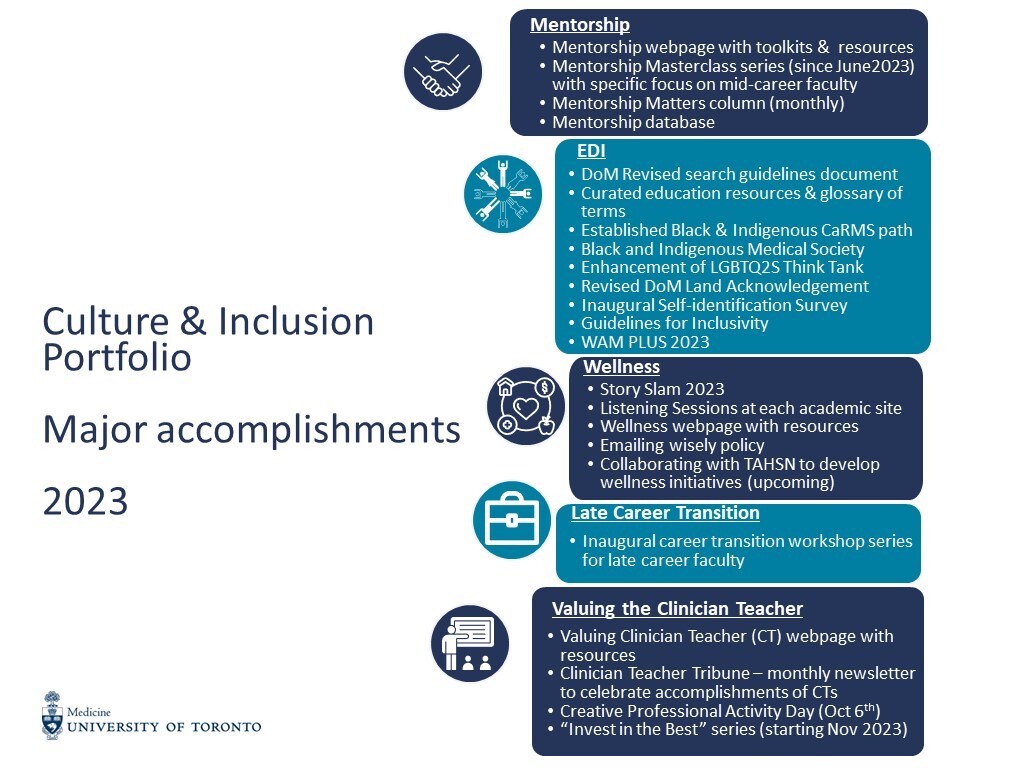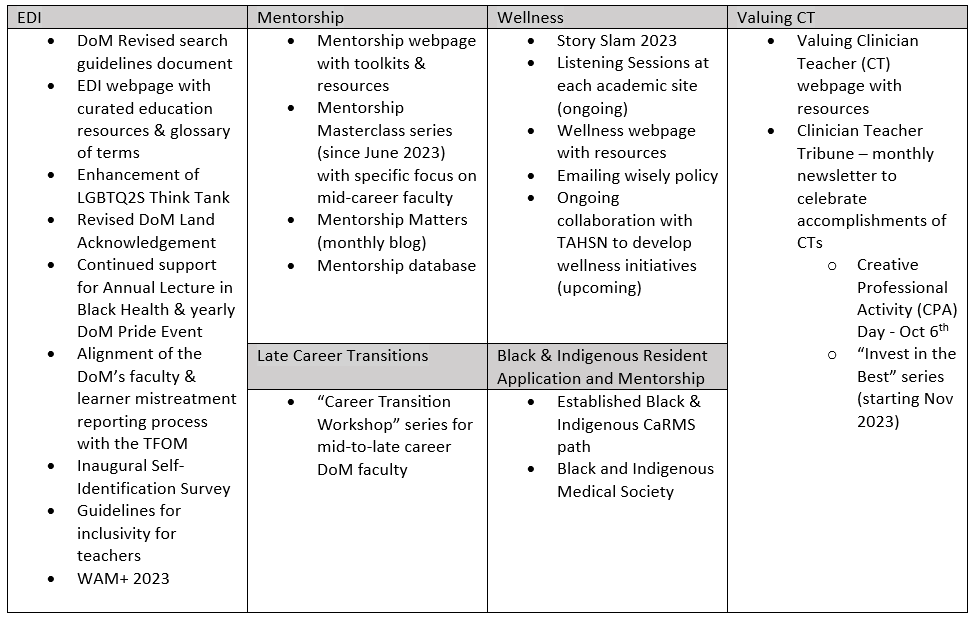How Far We Have Come

By Dr. Umberin Najeeb, Vice-Chair, Culture & Inclusion
On September 20th, I had the opportunity to host the Department of Medicine’s City-Wide Medical Grand Rounds on "New Opportunities to Accelerate Gender Equity for Women in Medicine." This event prompted me to pause and reflect on various recommendations shared during the rounds, leading me to undertake a critical overview of our department. Gender is, of course, only one element of diversity, and achieving gender-related equity and inclusion is only one step in ensuring an equitable, inclusive department.
The Department of Medicine (DoM) is one of the largest departments within the Temerty Faculty of Medicine (TFOM), representing approximately 27% of TFOM faculty members. In 2014, the DoM comprised of 711 full-time clinical faculty members, of whom 36% were women. However, it is worth highlighting that the representation of women within the department varied significantly by specialty, ranging from 16% in cardiology to a commendable 63% in rheumatology. Among the departmental leadership team (Departmental Division Directors, hospital Physician-in-Chiefs, department Vice-Chairs and Chair), 26% were women. Consistent with Canadian and US academic medicine data, only 25% of our full professors were women*. These statistics present a stark contrast to the scenario within our medical school, where gender parity has been upheld for more than three decades, and in our residency training programs, where approximately half of the participants are women*.
Our commitment to fostering gender diversity and inclusion is evident in the progress we've made. In 2023, among our 946 full-time faculty members (who are hired after formal search and recruitment process), the breakdown is as follows:
- 42% identify as female
- 57% identify as male
- 1% identify as non-binary
Through ongoing leadership from our department Chair, Dr. Gillian Hawker, and structured mentorship, coaching programs and resources, we have increased the representation of full-time female and non-binary faculty members from 36% in 2014 to 42% in 2022. Currently, 42% of full-time faculty at the rank of Lecturer are female or non-binary, while the proportions are 50.6% and 41.7% for faculty at the rank of Assistant and Associate Professor, respectively. Notably, women now make 30% of full-time professors in the department compared to 25% in 2018. This transformation has enabled greater diversity in the DoM’s leadership roles from a gender perspective.
Notably, we've also made strides in addressing underrepresentation within specific specialties. For example, in 2014, female and non-binary individuals made up only 16% of over 100 full-time cardiologists, compared to 27% in 2023.
Furthermore, our commitment to gender diversity extends to leadership positions. Our Department Chair is a woman, and among the four Vice-Chairs in the DoM, two are women. Of the 20 Departmental Division Directors (DDDs), 13 are women, with larger divisions like Cardiology, GIM, and Emergency Medicine being led by women DDDs. Additionally, four of the six largest teaching hospitals are led by women Physician in Chiefs (PICs).
It's important to recognize that diversity encompasses a wide range of dimensions, including but not limited to age, race, ethnicity, religion, Indigeneity, self-identification as LGBTQ2S+, socioeconomic status, and disability. Research increasingly demonstrates a strong link between Equity, Diversity, and Inclusion (EDI) initiatives and achieving excellence across various domains, such as improved health outcomes, a better learning environment, and increased research productivity.
From our 2022 Faculty survey (60% response rate), 10% of our respondents reported being from a group that is underrepresented in medicine (URM) based on gender/sexual orientation, 20% based on race, religion or ethnicity, and 2% based on other aspects of their identity (e.g. age, language, immigration status, socioeconomic status).
While we have made substantial progress over the past decade from establishing formal search processes to enhancing gender diversity, our work is far from complete. We must continue to build momentum and enhance representation, particularly from an intersectional perspective. To support these efforts, the Culture and Inclusion (CI) portfolio was established in 2019 as an evolution of the Mentorship, Equity, and Diversity (MED) portfolio. The CI portfolio assists our Chair in developing policies and practices that promote fairness, transparency, equity, and diversity among faculty, trainees, and staff.
As the Vice-Chair of Culture and Inclusion, I am honoured and privileged to lead this important portfolio to advance the department’s strategic priorities related to mentorship across the academic lifespan, equity, diversity, inclusion, and faculty/learner wellness, with the invaluable support of the CI team. The three key pillars of the CI portfolio—Wellness, Equity, Diversity, and Inclusion (EDI), and Mentorship—are interconnected, and our CI leadership team collaborates closely to infuse these values into all facets of the DoM.
My ultimate objective is to nurture a culture that actively attracts, embraces, supports, and advances diverse talent across every stage of the academic lifecycle. Our commitment to this goal is exemplified through various CI initiatives, as detailed in Table 1 (see below). For instance, we initiated the self-identification survey (inaugurated in 2021) to capture the diversity within the department’s faculty members. The survey results revealed that only 2.3% of our faculty identified as Black and 0.8% as Indigenous. This led to efforts to enhance the current Black and Indigenous CaRMS application pathway in the Core Internal Medicine Program to ultimately increase our Black and Indigenous faculty members, and to ensure sustainability of the program and proportionate population representation. Best practices from this path are now being implemented across all the PGY1 and PGY4 programs in the department.
Additionally, the Guidelines for DoM Search Committees for faculty and leadership recruitment were revised and updated with an intersectionality lens to ensure that the DoM is representative of the learners we educate and the communities we serve. Our objective is to cultivate a more inclusive environment, fostering diversity in our hiring practices throughout the DoM community, thereby mitigating unconscious bias and avoiding the perpetuation of institutional reproduction. It's worth noting that these revised guidelines received approval from the DoM Executive Committee in January 2023 and are presently being implemented across all divisions within the DoM.
To facilitate knowledge enhancement and faculty development, we have launched the Culture and Inclusion website. This dynamic platform offers curated resources on dedicated EDI, wellness, mentorship, and valuing clinician teacher webpages. In our pursuit of further advancing mentorship, we have introduced initiatives such as the Mentorship Masterclass series (specifically focussing on mid-career faculty), DoM Mentorship Matters (a monthly blog series highlighting mentorship challenges and accomplishments), the development of a DoM mentorship database, and mentorship consultation services. We are committed to creating a culture that prioritizes faculty wellness. Ongoing support of CTUs in the challenging time of COVID-19, co-leading a working group with the Toronto Academic Health Sciences Network (TAHSN) to help standardize wellness initiatives across multiple academic institutions where our faculty is housed in, and supporting our individual faculty continues to be the ongoing priority.
Our CI portfolio continues to innovate with the creation of the Faculty Lead positions for Late Career Transition and Valuing Clinician Teacher (VCT). These roles exemplify our ongoing commitment to inclusive excellence. We have also initiated a “career transition workshop” series for late-career faculty, introduced a monthly newsletter called the "Clinician Teacher Tribune" to celebrate the achievements of our Clinician Teacher colleagues, and are preparing for the upcoming CPA Day.
We are eager to continue progressing on this journey towards a more inclusive and equitable department. Our vision includes celebrating diversity, fostering a sense of belonging, and nurturing a culture of fulfillment and worth for every member of our DoM community. Together, we are shaping a brighter future.
*Association of American Medical Colleges website. The state of women in academic medicine: the pipeline and pathways to leadership, 2013 - 2014. www.aamc.org/members/gwims/statistics. Accessed March 20, 2017.

